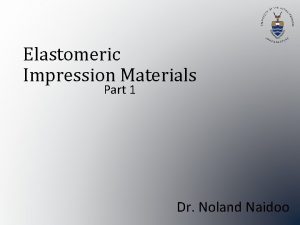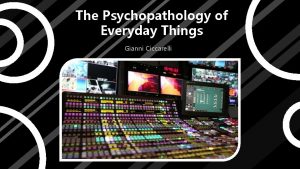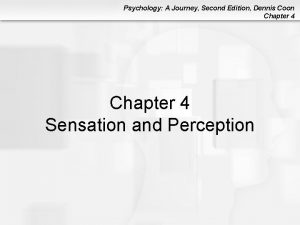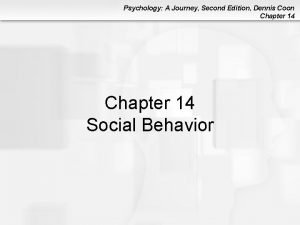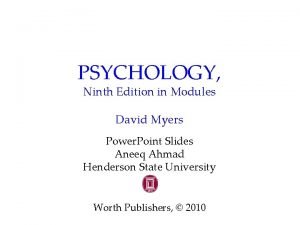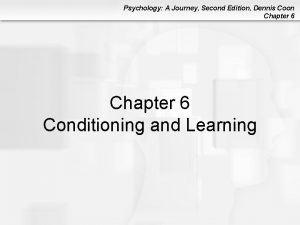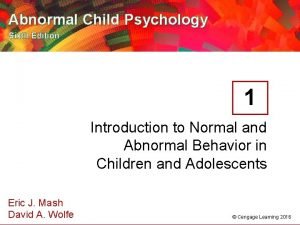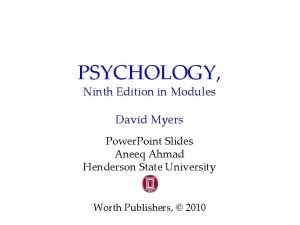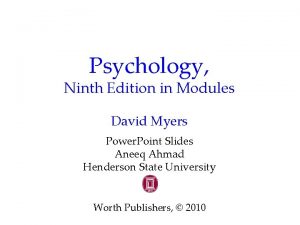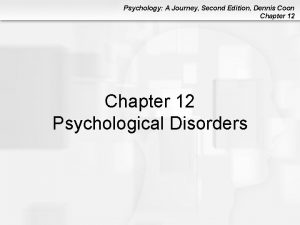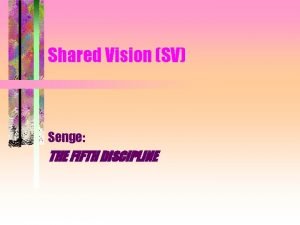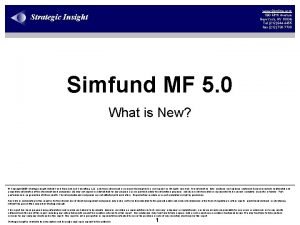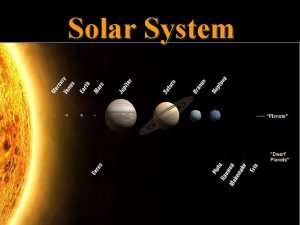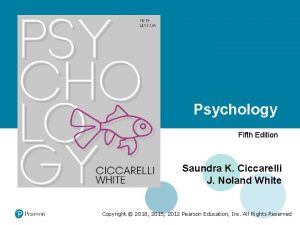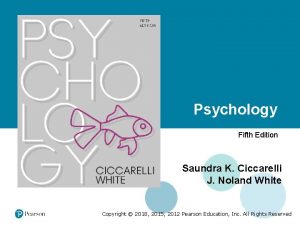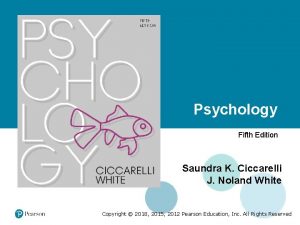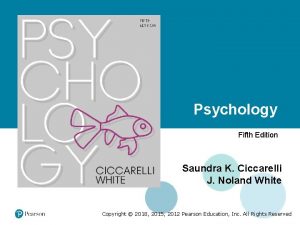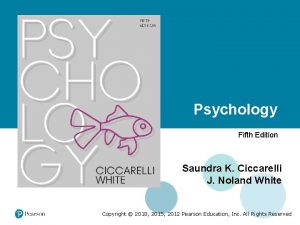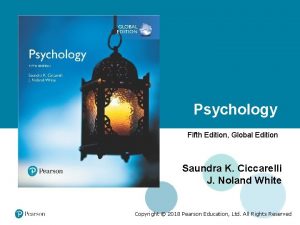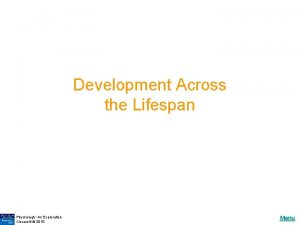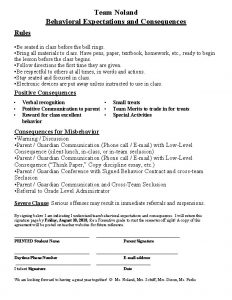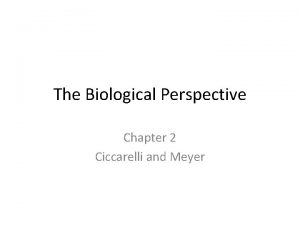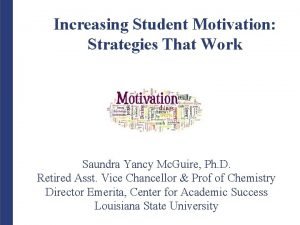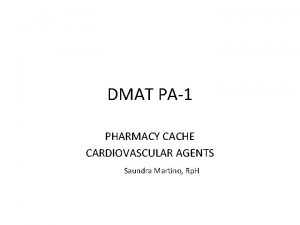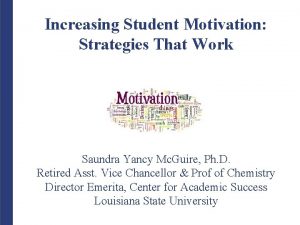Psychology Fifth Edition Saundra K Ciccarelli J Noland














































- Slides: 46

Psychology Fifth Edition Saundra K. Ciccarelli J. Noland White Copyright © 2018, 2015, 2012 Pearson Education, Inc. All Rights Reserved

Psychology Fifth Edition Chapter 99 Motivation and Emotion

Learning Objectives 1 of 2 9. 1 Distinguish between intrinsic motivation and extrinsic motivation. 9. 2 Identify the key elements of the early instinct and drivereduction approaches to motivation. 9. 3 Explain the characteristics of the three types of needs. 9. 4 Identify the key elements of the arousal and incentive approaches to motivation. 9. 5 Describe how Maslow’s hierarchy of needs and selfdetermination theories explain motivation. 9. 6 Identify the physical and social factors that influence hunger.

Learning Objectives 2 of 2 9. 7 Recognize some of the factors that contribute to obesity. 9. 8 Describe three elements of emotion. 9. 9 Distinguish among the common-sense, James-Lange, Cannon-Bard, and facial feedback theories of emotion. 9. 10 Identify the key elements in the cognitive arousal and cognitive-mediational theories of emotion. 9. 11 Summarize the five steps of the GTD method.

Defining Motivation Learning Objective 9. 1 Distinguish between intrinsic motivation and extrinsic motivation. • Motivation: the process by which activities are started, directed, and continued so that physical or psychological needs or wants are met – Extrinsic motivation: a person performs an action because it leads to an outcome that is separate from or external to the person – Intrinsic motivation: a person performs an action because the act is fun, challenging, or satisfying in an internal manner

Early Approaches to Understanding Motivation 1 of 3 Learning Objective 9. 2 Identify the key elements of the early instinct and drivereduction approaches to motivation. • Instincts and the evolutionary approach: approach to motivation that assumes people are governed by instincts similar to those of animals • Instincts: the biologically determined and innate patterns of behavior that exist in both people and animals

Early Approaches to Understanding Motivation 2 of 3 • Drive-Reduction Theory: assumes behavior arises from physiological needs that cause internal drives to push the organism to satisfy the need and reduce tension and arousal • Need: a requirement of some material essential for survival of the organism • Drive: psychological tension and physical arousal when there is need that motivates organism to act in order to fulfill need and reduce tension

Early Approaches to Understanding Motivation 3 of 3 • Primary drives: involve needs of the body such as hunger and thirst • Acquired (secondary) drives: learned through experience or conditioning, such as the need for money or social approval • Homeostasis: the tendency of the body to maintain a steady state

Figure 9. 1 Homeostasis In homeostasis, the body maintains balance in its physical states. For example, this diagram shows how increased hunger (a state of imbalance) prompts a person to eat. Eating increases the level of glucose (blood sugar), causing the feelings of hunger to reduce. After a period without eating, the glucose levels become low enough to stimulate the hunger drive once again, and entire cycle is repeated.

Different Strokes for Different Folks: Psychological Needs 1 of 2 Learning Objective 9. 3 Explain the characteristics of the three types of needs. • Mc. Clelland’s Theory – Need for affiliation (n. Aff): the need for friendly social interactions and relationships with others – Need for power (n. Pow): the need to have control or influence over others – Need for achievement (n. Ach): involves a strong desire to succeed in attaining goals—not only realistic ones, but also challenging ones

Different Strokes for Different Folks: Psychological Needs 2 of 2 • Personality and n. Ach: Carol Dweck’s Self-theory of Motivation – Need for achievement closely linked to personality factors, including view of self – Locus of control: internal or external?

Arousal and Incentive Approaches 1 of 4 Learning Objective 9. 4 Identify the key elements of the arousal and incentive approaches to motivation. • Stimulus motive: a motive that appears to be unlearned but causes an increase in stimulation, such as curiosity • Arousal theory: theory of motivation in which people are said to have an optimal (best or ideal) level of tension that they seek to maintain by increasing or decreasing stimulation

Arousal and Incentive Approaches 2 of 4 • Yerkes-Dodson law: law stating performance is related to arousal; moderate levels of arousal lead to better performance than do levels of arousal that are too low or too high – Effect varies with the difficulty of the task ▪ Easy tasks require a high-moderate level ▪ More difficult tasks require a low-moderate level

Figure 9. 2 Arousal and Performance The optimal level of arousal for task performance depends on the difficulty of the task. We generally perform easy tasks well if we are at a high– moderate level of arousal (green) and accomplish difficult tasks well if we are at a low–moderate level (red).

Arousal and Incentive Approaches 3 of 4 • Sensation seeker: one who needs more arousal than the average person Does this look fun? If so, you may score relatively higher in sensation seeking.

Table 9. 1 Sample Items From the Zuckerman. Kuhlman Personality Questionnaire Scale Item Sensation Seeking I sometimes do “crazy” things just for fun. High I prefer friends who are exciting and unpredictable. High I am an impulsive person. High Before I begin a complicated job, I make careful plans. Low I usually think about what I am going to do before doing it. Low Source: Adapted from Zuckerman, M. (2002). Blank cell

Arousal and Incentive Approaches 4 of 4 • Incentive approaches: theories of motivation in which behavior is explained as a response to the external stimulus and its rewarding properties – Incentives: things that attract or lure people into action

Humanistic Approaches 1 of 2 Learning Objective 9. 5 Describe how Maslow’s hierarchy of needs and selfdetermination theories explain motivation. • Maslow’s Hierarchy of Needs – Several levels of need a person must strive for before reaching self-actualization – Self-actualization: point at which people have sufficiently satisfied the lower needs and achieved their full human potential – Peak experiences: times in a person’s life during which self-actualization is temporarily achieved

Figure 9. 3 Maslow’s Hierarchy of Needs Maslow proposed that human beings must fulfill the more basic needs, such as physical and security needs, before being able to fulfill the higher needs of self-actualization and transcendence.

Humanistic Approaches 2 of 2 • Self-determination theory (SDT): the social context of an action has an effect on the type of motivation existing for the action – Autonomy – Competence – Relatedness

Physiological and Social Components of Hunger 1 of 4 Learning Objective 9. 6 Identify the physical and social factors that influence hunger. • Hormonal Influences – Insulin and glucagon: hormones secreted by the pancreas to control levels of fats, proteins, and carbohydrates in the bloodstream ▪ Insulin reduces level of glucose in bloodstream ▪ Glucagon increases level of glucose in bloodstream – Leptin: hormone that signals the hypothalamus that the body has had enough food and reduces the appetite while increasing the feeling of being full

Physiological and Social Components of Hunger 2 of 4 • Role of the Hypothalamus – Responds to levels of glucose and insulin in the body – Leptin: hormone that signals hypothalamus that body has had enough food, and reduces appetite while increasing feeling of being full Figure 9. 4 The rat on the left has reached a high level of obesity because its ventromedial hypothalamus has been deliberately damaged in the laboratory. The result is a rat that no longer receives signals of being satiated, and so the rat continues to eat and eat.

Physiological and Social Components of Hunger 3 of 4 • Weight set point: the particular level of weight that the body tries to maintain • Basal metabolic rate (BMR): the rate at which the body burns energy when the organism is resting

Figure 9. 5 Average BMR for a Female and Male *Numbers in the table represent the number of calories a person needs to consume each day to maintain body weight (without exercise)

Physiological and Social Components of Hunger 4 of 4 • Social Components of Hunger – – – Social cues Food preferences Cultural factors Gender Comfort device or escape from unpleasantness ▪ Some people may respond to anticipation of eating by producing an insulin response

Obesity Learning Objective 9. 7 Recognize some of the factors that contribute to obesity. • Obesity – Body weight is 20 percent or more over the ideal body weight for that person’s height – Biological causes include heredity, hormones, and slowing metabolism with age – Overeating – Stress

The Three Elements of Emotion 1 of 4 Learning Objective 9. 8 Describe three elements of emotion. • Emotion: the “feeling” aspect of consciousness characterized by: – Certain physical arousal – Certain behavior that reveals emotion to outside world – Inner awareness of feelings

The Three Elements of Emotion 2 of 4 • Which parts of the brain are involved in various aspects of emotion? – Amygdala ▪ A complex structure with many different nuclei and subdivisions, whose roles have been investigated primarily through studies of fear conditioning ▪ Emotional stimuli travel to the amygdala by both a fast, crude “low road” (subcortical) and a slower but more involved cortical “high road”

Figure 9. 6 The “Low Road” and “High Road” When we are exposed to an emotion-provoking stimulus (such as a shark), the neural signals travel by two pathways to the amygdala. The “low road” is the pathway underneath the cortex and is a faster, simpler path, allowing for quick responses to the stimulus, sometimes before we are consciously aware of the nature of the stimulus. The “high road” uses cortical pathways and is slower and more complex, but it allows us to recognize threat and, when needed, take more conscious control of our emotional responses. In this particular example, the low road shouts, “Danger!” and we react before the high road says, “It’s a shark!”

The Three Elements of Emotion 3 of 4 • Which parts of the brain are involved in various aspects of emotion? – Other subcortical and cortical areas ▪ ▪ Hemisphere Frontal lobes Anterior cingulate cortex Lateral orbitofrontal cortex

The Three Elements of Emotion 4 of 4 • Emotional Expression – Facial expressions vary across different cultures – Display rules ▪ Differ by gender ▪ Differ by culture • Labeling Emotion ▪ Interpreting subjective feelings by giving it a label ▪ Cognitive element

Figure 9. 7 Facial Expressions of Emotion Facial expressions appear to be universal. For example, these faces are consistently interpreted as showing (a) anger, (b) fear, (c) disgust, (d) happiness, (e) surprise, and (f) sadness by people of various cultures from all over the world. Although the situations that cause these emotions may differ from culture to culture, the expression of particular emotions remains strikingly the same.

Early Theories of Emotion 1 of 4 Learning Objective 9. 9 Distinguish among the common-sense, James-Lange, Cannon-Bard, and facial feedback theories of emotion. • Common sense theory of emotion: a stimulus leads to an emotion, which then leads to bodily arousal

Figure 9. 8 Common Sense Theory of Emotion In the common-sense theory of emotion, a stimulus (snarling dog) leads to an emotion of fear, which then leads to bodily arousal (in this case, indicated by shaking) through the autonomic nervous system (ANS).

Early Theories of Emotion 2 of 4 • James-Lange theory of emotion: a physiological reaction leads to the labeling of an emotion

Figure 9. 9 James-Lange Theory of Emotion In the James-Lange theory of emotion, a stimulus leads to bodily arousal first, which is then interpreted as an emotion.

Early Theories of Emotion 3 of 4 • Cannon-Bard theory of emotion: the physiological reaction and the emotion are assumed to occur at the same time

Figure 9. 10 Cannon-Bard Theory of Emotion In the Cannon-Bard theory of emotion, a stimulus leads to activity in the brain, which then sends signals to arouse the body and interpret the emotion at the same time.

Early Theories of Emotion 4 of 4 • Facial feedback hypothesis: facial expressions provide feedback to the brain concerning the emotion being expressed, which in turn causes and intensifies the emotion

Figure 9. 11 Facial Feedback Theory of Emotion In the facial feedback theory of emotion, a stimulus such as this snarling dog causes arousal and a facial expression. The facial expression then provides feedback to the brain about the emotion. The brain then interprets the emotion and may also intensify it.

Cognitive Theories of Emotion 1 of 2 Learning Objective 9. 10 Identify the key elements in the cognitive arousal and cognitive-mediational theories of emotion. • Cognitive arousal theory: both the physical arousal and labeling of that arousal based on cues from the environment must occur before the emotion is experienced

Figure 9. 12 Schachter-Singer Cognitive Arousal Theory of Emotion Schachter and Singer’s cognitive arousal theory is similar to the James-Lange theory but adds the element of cognitive labeling of the arousal. In this theory, a stimulus leads to both bodily arousal and the labeling of that arousal (based on the surrounding context), which leads to the experience and labeling of the emotional reaction.

Cognitive Theories of Emotion 2 of 2 • Cognitive-mediational theory: a stimulus must be interpreted (appraised) by a person in order to result in a physical response and an emotional reaction

Figure 9. 13 Lazarus’s Cognitive-Mediational Theory of Emotion In Lazarus’s cognitive-mediational theory of emotion, a stimulus causes an immediate appraisal (e. g. , “The dog is snarling and not behind a fence, so this is dangerous”). The cognitive appraisal results in an emotional response, which is then followed by the appropriate bodily response.

Figure 9. 14 Comparison of Theories of Emotion These figures represent the six different theories of emotion as discussed.

When Motivation Is Not Enough Learning Objective 9. 11 Summarize the five steps of the GTD method. • Getting Things Done methodology 1. Capture anything that has your attention in one place. 2. Process and define what you can take action on and identify the next steps. 3. Organize information and reminders into categories based on how and when you need them. 4. Complete weekly reviews of your projects, next actions, and new items. 5. Do your next actions in the appropriate context or time frame for doing so.
 Lazarus theory
Lazarus theory Saundra stock md
Saundra stock md Advantages and disadvantages of addition silicone
Advantages and disadvantages of addition silicone Chuck noland character analysis
Chuck noland character analysis Fundamentals of corporate finance fifth edition
Fundamentals of corporate finance fifth edition Human anatomy fifth edition
Human anatomy fifth edition Democritus atomic model diagram
Democritus atomic model diagram Human anatomy fifth edition
Human anatomy fifth edition Molecular biology
Molecular biology Principles of marketing fifth european edition
Principles of marketing fifth european edition Molecular biology
Molecular biology Dg devco organigramme
Dg devco organigramme Gianni ciccarelli
Gianni ciccarelli Stephanie ciccarelli
Stephanie ciccarelli Mis
Mis Using mis (10th edition) 10th edition
Using mis (10th edition) 10th edition Psychology
Psychology Psychology ninth edition in modules
Psychology ninth edition in modules Psychology tenth edition david g myers
Psychology tenth edition david g myers Fundamentals of abnormal psychology ninth edition
Fundamentals of abnormal psychology ninth edition Psychology a journey 4th edition chapter 1
Psychology a journey 4th edition chapter 1 Psychology eighth edition david g myers
Psychology eighth edition david g myers Psychology ninth edition in modules
Psychology ninth edition in modules Psychology ninth edition david g myers
Psychology ninth edition david g myers Psychology a journey 4th edition chapter 1
Psychology a journey 4th edition chapter 1 Equifinality psychology
Equifinality psychology Social psychology ninth edition
Social psychology ninth edition Psychology ninth edition in modules
Psychology ninth edition in modules Psychology a journey
Psychology a journey David g myers psychology 8th edition
David g myers psychology 8th edition Social psychology is the scientific study of
Social psychology is the scientific study of Social psychology definition psychology
Social psychology definition psychology Health psychology definition ap psychology
Health psychology definition ap psychology Social psychology ap psychology
Social psychology ap psychology Introspection method of psychology
Introspection method of psychology Positive psychology ap psychology definition
Positive psychology ap psychology definition Iot design methodology is to provide
Iot design methodology is to provide Senge shared vision
Senge shared vision Fifth element strain
Fifth element strain Fifth ward junior high school
Fifth ward junior high school Arterial blood pressure
Arterial blood pressure Fifth episcopal district
Fifth episcopal district Fifth gear loop the loop
Fifth gear loop the loop Nanda nursing diagnosis
Nanda nursing diagnosis Sionline.com
Sionline.com The fifth, sixth, seventh, and eighth amendments protect *
The fifth, sixth, seventh, and eighth amendments protect * Solar system in circle
Solar system in circle


